
The Lutheran Church – Missouri Synod (LCMS), also known as the Missouri Synod, is an orthodox, traditional, confessional Lutheran denomination in the United States. With 1.7 million members as of 2022 it is the second-largest Lutheran body in the United States, behind the Evangelical Lutheran Church in America. The LCMS was organized in 1847 at a meeting in Chicago, as the German Evangelical Lutheran Synod of Missouri, Ohio, and Other States, a name which partially reflected the geographic locations of the founding congregations.
Thrivent Financial for Lutherans, is an American Fortune 500 not-for-profit financial services organization headquartered in Minneapolis, Minnesota, and Appleton, Wisconsin, and founded by Lutherans. As a member-owned fraternal benefit society, it operates under a chapter system, serving nearly 2.3 million members.

The Judson Memorial Church is located on Washington Square South between Thompson Street and Sullivan Street, near Gould Plaza, opposite Washington Square Park, in the Greenwich Village neighborhood of the New York City borough of Manhattan. It is affiliated with the American Baptist Churches USA, the Alliance of Baptists, and with the United Church of Christ.
The Synod of Evangelical Lutheran Churches (SELC) was an American Lutheran denomination that existed from 1902 to 1971. It merged with the Lutheran Church – Missouri Synod (LCMS) in 1971 and now operates as the non-geographic SELC District of that body.
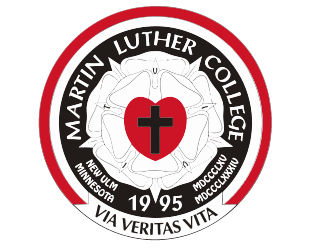
Martin Luther College (MLC) is a private Lutheran college in New Ulm, Minnesota. It is operated by the Wisconsin Evangelical Lutheran Synod (WELS). Martin Luther College was established in 1995, when Northwestern College (NWC) of Watertown, Wisconsin, combined with Dr. Martin Luther College (DMLC) of New Ulm on the latter's campus.
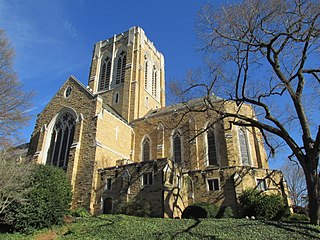
The Cathedral of Saint Philip, also known as St. Philip's Cathedral or St. Philip's is an Episcopal cathedral in the U.S. State of Georgia, in the City of Atlanta. Located on Peachtree Road in Buckhead (Atlanta) at what is popularly called "Jesus Junction". St. Philip's has become one of the largest Episcopal congregations in the United States, with a membership of approximately 7,000. St. Philip's is named in honor of St. Philip the Evangelist, a deacon in the early Christian Church. The Cathedral of St. Philip is the seat of the Episcopal Diocese of Atlanta.

St. Elizabeth's Church of the Catholic Third Order of Saint Francis is a Gothic church in Wrocław, Poland. It is one of the most iconic structures of the city's Old Town panorama.
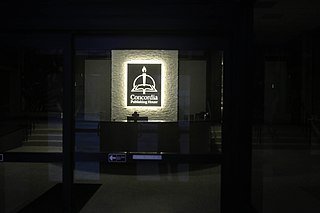
Concordia Publishing House (CPH), founded in 1869, is the official publishing arm of the Lutheran Church–Missouri Synod (LCMS). Headquartered in St Louis, Missouri, at 3558 S. Jefferson Avenue, CPH publishes the synod's official monthly magazine, The Lutheran Witness, and the synod's hymnals, including The Lutheran Hymnal (1941), Lutheran Worship (1982), and Lutheran Service Book (2006). It publishes a wide range of resources for churches, schools, and homes and is the publisher of the world's most widely circulated daily devotional resource, Portals of Prayer. Its children's books, known as Arch Books, have been published in millions of copies. Concordia Publishing House is the oldest publishing company west of the Mississippi River and the world's largest distinctly Lutheran publishing house.

So Others Might Eat (SOME) is a nonprofit organization that provides services to assist those dealing with poverty and homelessness in Washington, D.C. The organization provides affordable housing, job training, counseling and other healthcare services, and daily needs such as food and clothing to the poor and homeless. It spends the largest portion of its annual budget on affordable housing, with a majority of its residents recovering from addiction. SOME describes its mission as helping "our vulnerable neighbors in Washington, DC, break the cycle of homelessness through our comprehensive and transformative services".

National City Christian Church, located on Thomas Circle in Washington, D.C., is the national church and cathedral of the Christian Church. The denomination grew from the Stone-Campbell Movement founded by Thomas Campbell and Alexander Campbell of Pennsylvania and West Virginia and Barton W. Stone of Kentucky. National City Christian Church is currently led by The Rev. Stephanie Kendell, the church's first woman called to be their Senior Minister and President.

The National Presbyterian Church is a Christian congregation of approximately 1,500 members of all ages from the greater metropolitan Washington, D.C. area. The mission statement of the church is "Leading People to Become Faithful Followers of Jesus Christ Together in God's World"
The Lutheran Volunteer Corps (LVC) is a full-time, volunteer service and leadership program. It was founded in 1979 by Luther Place Memorial Church in Washington, DC. Each year, LVC places approximately 100 volunteers in urban areas across the United States to work for social justice with various nonprofit organizations. The program lasts one to two years. The volunteers live together in the areas they serve and are encouraged to explore living simply and sustainably in intentional community.

All Angels' Church is located on 251 West 80th Street in the Upper West Side of Manhattan in New York City. It is a member of the Episcopal Church in the United States and the Anglican Communion worldwide.

Bread for the City is a comprehensive front line agency serving the poor of Washington, D.C., USA. The agency began as two organizations: Zacchaeus Free Clinic, and Bread for the City, a project by a coalition of downtown DC churches created in 1974 to feed and clothe the poor. As of 2011 Bread for the City offered food, clothing, social services, legal representation and medical care without charge to eligible DC residents.
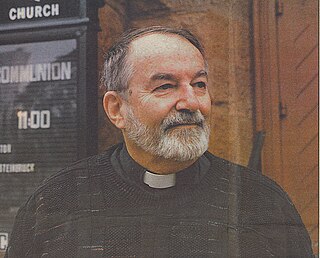
John Frederick Steinbruck was an ordained Lutheran minister who served for 28 years (1970–1997) as the senior pastor of Luther Place Memorial Church in Washington, D.C. Luther Place is an historic, red-stone church located at Thomas Circle, 1226 Vermont Avenue, N.W., in the heart of Washington's red-light district. Less than a mile from the White House, the church sits between the symbols of world power and some of the nation's worst urban blight. As spiritual leader of Luther Place and what is now known as N Street Village, a diverse consortium of shelters and services for homeless women and their families, Steinbruck became an articulate and passionate preacher of the Social Gospel and a leading voice locally and nationally for the homeless, Central American refugees, and the victims of persecution and prejudice.
Pacific Unitarian Church is a Unitarian Universalist congregation located in Rancho Palos Verdes, California. It is a member of the Unitarian Universalist Association of Congregations, within the Pacific Southwest District. PUC was recognized as one of four "Breakthrough Congregations" in 2008, reflected in a $75,000 donation to Community Church UU of New Orleans. Membership as of 2019 is around 180 with weekly attendance averaging over 90 adults and children.

The Luther Monument is a public artwork located in front of Luther Place Memorial Church in Washington, D.C., United States. The monument to Martin Luther, the theologian and Protestant Reformer, is a bronze, full-length portrait. It is a copy of the statue created by Ernst Friedrich August Rietschel as part of the 1868 Luther Monument in Worms, Germany. The version in Washington, D.C., inspired the installation of many other castings across the U.S. The statue is a contributing property to the Luther Place Memorial Church's listing on the National Register of Historic Places (NRHP) and District of Columbia Inventory of Historic Sites (DCIHS). It is also a contributing property to the Greater Fourteenth Street Historic District, which is also listed on the NRHP and DCIHS.

The German Evangelical Lutheran Church of Charleston, South Carolina, was incorporated on December 3, 1840. Through usage and custom the Church is now known as St. Matthew's German Evangelical Lutheran Church or St. Matthew's Lutheran Church and is a member of the South Carolina Synod of the Evangelical Lutheran Church in America.
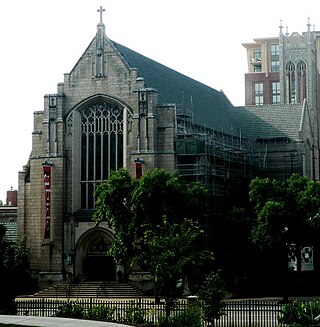
Luther Memorial Church is a Lutheran congregation at 1021 University Avenue in Madison, Wisconsin in the United States. A member of the Evangelical Lutheran Church in America (ELCA), it is known for its worship, music, education, social ministry and preschool programs. The congregation's cathedral-like Neogothic-style building, designed by local architects Claude & Starck and built in 1923, was added to the National Register of Historic Places in 2018.

Joseph W. Ellwanger Jr. is a Lutheran pastor, author, and civil rights activist. He was a key figure in the Civil Rights Movement in Birmingham, Alabama, and the only white religious leader included in strategy meetings with Martin Luther King Jr.




















